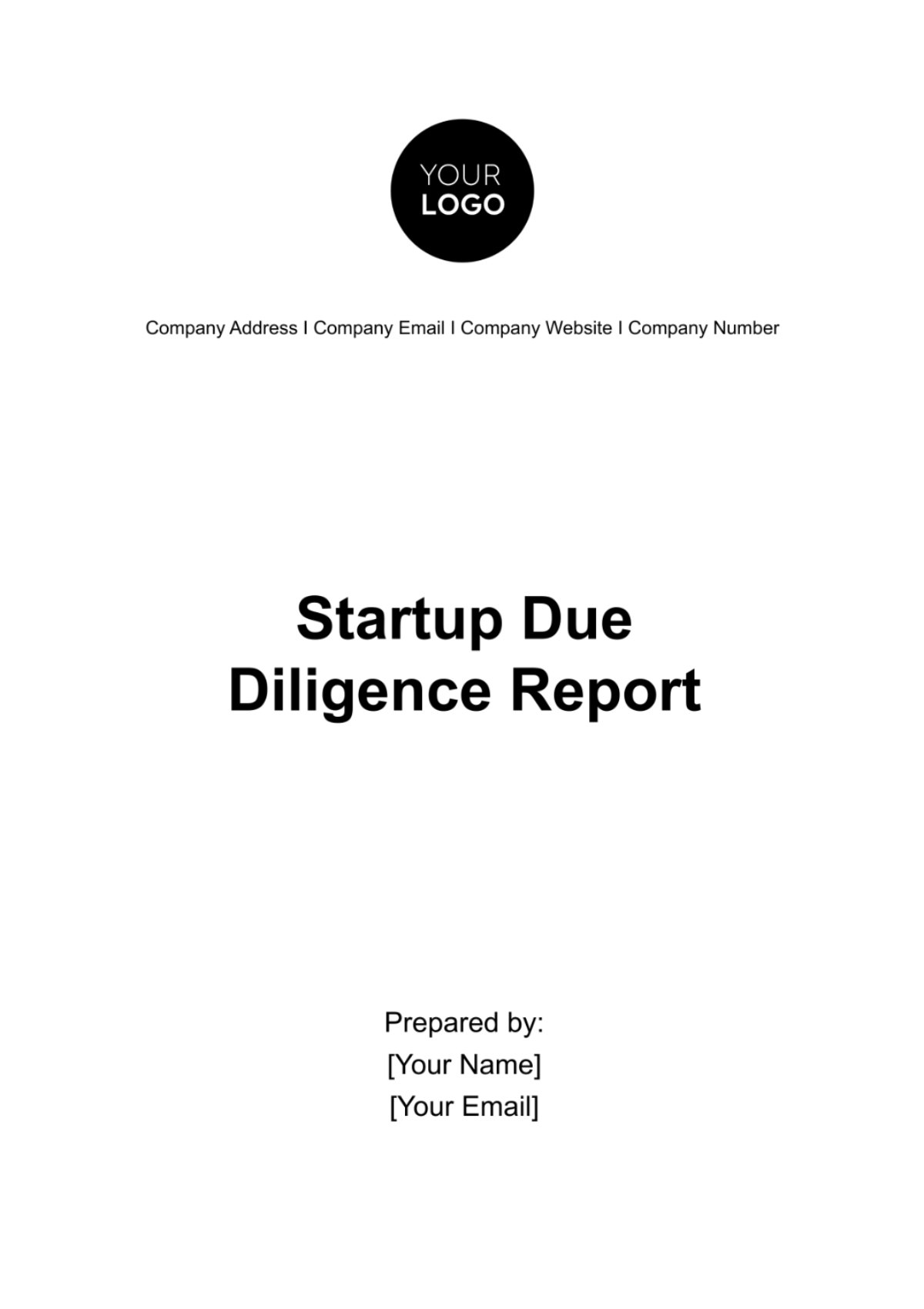Startup Due Diligence Report
Date Prepared: [Date]
Executive Summary
The startup exhibits an exceptional capacity for innovation and adaptability, positioning it as a versatile player across a spectrum of industries including technology, healthcare, finance, and beyond. Notably, its strategic prowess in identifying and capitalizing on market gaps underscores its potential to yield substantial returns for investors. This summary encapsulates the startup's overarching strengths, market opportunities, and strategic imperatives, offering a compelling glimpse into its potential for transformative impact across various sectors.
Company Overview
[Your Company Name,] founded by a visionary team with extensive experience across multiple industries last [Year], has established a reputation for pioneering solutions that transcend traditional boundaries. Its diverse portfolio spans technology, healthcare, finance, and beyond, reflecting a commitment to addressing complex challenges with ingenuity and expertise. With a track record of success and a culture of innovation, the startup is poised to redefine industry standards and carve out a niche in each sector it serves.
Investment Rationale
The rationale behind the startup's pursuit of investment or partnership stems from a meticulous analysis of market dynamics and technological trends across various industries. In each sector, there exists a distinct opportunity to address unmet needs or inefficiencies through innovative solutions. By seeking investment, the startup aims to catalyze its growth trajectory, accelerate product development, and expand market reach.
In the technology sector, rapid digitization and the adoption of cloud-based solutions present a ripe environment for disruptive innovations. The startup's cutting-edge technology and agile development methodologies position it to capitalize on emerging trends such as artificial intelligence, blockchain, and Internet of Things (IoT). Investment will facilitate the scaling of operations and the enhancement of product capabilities to meet the evolving demands of tech-savvy consumers and enterprises.
Similarly, in the healthcare industry, the convergence of healthcare and technology opens avenues for transformative solutions that improve patient outcomes, streamline workflows, and reduce costs. The startup's healthcare-focused initiatives, including telemedicine platforms, digital health records, and AI-driven diagnostics, align with the industry's shift towards value-based care and patient-centricity. Investment will enable the startup to navigate complex regulatory landscapes, forge strategic partnerships with healthcare providers, and drive innovation in personalized medicine and population health management.
In the finance sector, the advent of fintech disruptors and changing consumer behaviors underscore the need for agile and customer-centric financial services. The startup's fintech solutions, spanning digital payments, peer-to-peer lending, and robo-advisory platforms, resonate with a growing segment of digitally-native consumers seeking convenience, transparency, and personalized financial solutions. Investment will fuel the development of robust security protocols, compliance frameworks, and data analytics capabilities to ensure regulatory compliance and enhance customer trust in an increasingly digitized financial ecosystem.
Financial Review
Revenue Streams:
Diversified revenue streams across multiple industries, including technology, healthcare, finance, and consumer goods.
Subscription-based models, licensing agreements, and product sales contribute to stable and recurring revenue.
Profitability Analysis:
Healthy profit margins driven by efficient cost management and economies of scale.
Projections indicate sustained profitability with potential for margin expansion through optimization and scale.
Cash Flow Analysis:
Strong cash flow generation bolstered by steady revenue streams and disciplined expenditure.
Adequate liquidity to support operational needs and strategic investments for growth.
Funding Requirements:
Financial Projections:
Optimistic yet realistic financial projections based on market analysis, historical performance, and growth trajectory.
Forecasted revenue growth, profitability milestones, and cash flow projections demonstrate the startup's potential to deliver value to investors.
Capital Structure:
Efficient capital structure with a balanced mix of equity and debt financing to optimize cost of capital and mitigate financial risk.
Strategic approach to capital allocation and financing strategies tailored to support long-term growth objectives.
SWOT Analysis
Strengths | Weaknesses |
|---|---|
- Innovative technology solutions | - Reliance on limited key personnel |
- Strong intellectual property portfolio | - Limited brand recognition |
- Agile and adaptable organizational culture | - Vulnerability to regulatory changes |
- Strategic partnerships and alliances | - Dependence on external funding sources |
- Robust financial performance | - Lack of diversified revenue streams |
Opportunities | Threats |
|---|---|
- Expansion into emerging markets | - Intense competition from larger incumbents |
- Growth potential in untapped industries | - Rapid technological obsolescence |
- Strategic mergers and acquisitions | - Regulatory hurdles and compliance risks |
- Rising demand for sustainable solutions | - Economic downturns and market volatility |
- Leveraging data analytics for personalized offerings | - Cybersecurity threats and data breaches |
Risks and Mitigation Strategies
Mitigation strategies encompass a comprehensive approach to address potential risks inherent in various industries. Regulatory compliance is a priority, with dedicated teams ensuring adherence to evolving standards and minimizing legal exposure. Cybersecurity measures are implemented to safeguard sensitive data and protect against cyber threats, mitigating operational disruptions and reputational damage.
Market volatility and competitive pressures are mitigated through diversification strategies, product differentiation, and strategic alliances. Supply chain resilience is ensured through robust vendor management protocols and alternative sourcing options, reducing dependency on single suppliers and mitigating supply chain disruptions.
Operational risks, including technology failures and talent attrition, are addressed through contingency planning, redundancy measures, and ongoing skill development initiatives. Business continuity plans are established to mitigate the impact of unforeseen events such as natural disasters or pandemics, ensuring uninterrupted service delivery and customer satisfaction.
Financial risks, such as cash flow constraints and economic downturns, are managed through prudent financial planning, including scenario analysis and stress testing. Access to diverse funding sources, including venture capital, grants, and strategic partnerships, enhances financial flexibility and resilience to market fluctuations.
Strategic risks, such as misalignment with market trends or over-reliance on a single product or market segment, are mitigated through rigorous market analysis, scenario planning, and agile decision-making processes. Continuous monitoring of industry trends and customer feedback facilitates proactive adjustments to strategic direction, minimizing risks and maximizing opportunities for growth.
Operational Assessment
Scalability and Infrastructure:
Scalable infrastructure supports future growth and expansion.
Robust technology stack ensures reliability and performance.
Flexibility to adapt to evolving market demands and customer needs.
Process Efficiency:
Streamlined processes optimize resource allocation and minimize waste.
Continuous improvement initiatives enhance operational efficiency.
Automation and digitization streamline workflows and reduce manual errors.
Supply Chain Management:
Strategic partnerships and vendor relationships ensure timely delivery and cost optimization.
Risk mitigation strategies address supply chain disruptions and dependencies.
Transparency and collaboration foster trust and accountability throughout the supply chain.
Talent Management:
Recruitment of top talent with industry expertise and innovative mindset.
Ongoing training and development programs nurture skills and foster employee engagement.
Performance incentives and career advancement opportunities promote retention and loyalty.
Legal and Compliance
Regulatory Compliance:
Comprehensive understanding of industry regulations and compliance requirements.
Regular audits and assessments ensure adherence to legal standards and best practices.
Proactive approach to regulatory changes mitigates compliance risks and ensures business continuity.
Intellectual Property Protection:
Robust intellectual property strategy safeguards innovations and proprietary technologies.
Patents, trademarks, and copyrights protect valuable assets from infringement.
Enforcement measures deter unauthorized use and maintain competitive advantage.
Contract Management:
Clear and concise contracts outline rights, obligations, and dispute resolution mechanisms.
Regular reviews and updates ensure alignment with evolving business needs and regulatory changes.
Effective contract management tools streamline processes and mitigate legal risks.
Litigation Management:
Proactive risk assessment and dispute resolution strategies minimize litigation exposure.
Collaboration with legal counsel and experts to navigate complex legal challenges.
Contingency plans and insurance coverage mitigate financial and reputational risks associated with litigation.
Conclusion
The startup's multidisciplinary approach and industry-agnostic solutions position it as a formidable player in today's dynamic business landscape. Recommendations focus on leveraging strengths, mitigating risks, and capitalizing on growth opportunities across diverse sectors. With a clear roadmap and commitment to excellence, the startup is poised for sustainable success.



































